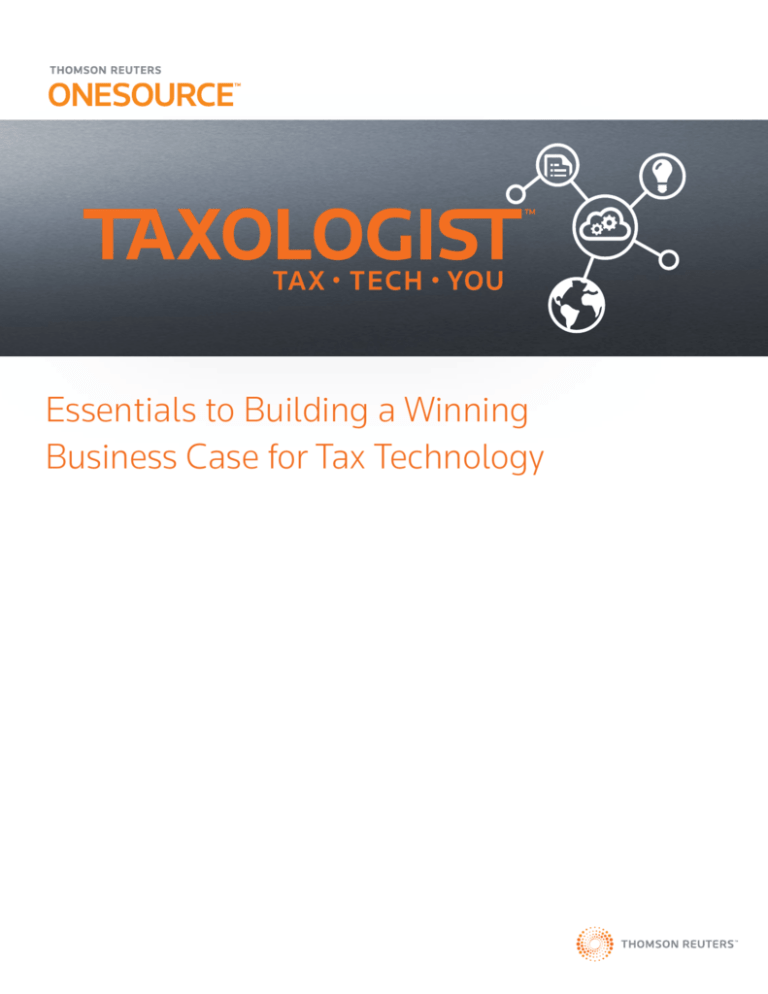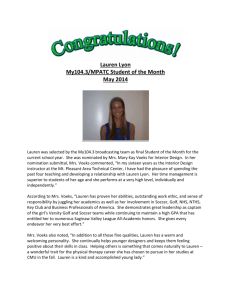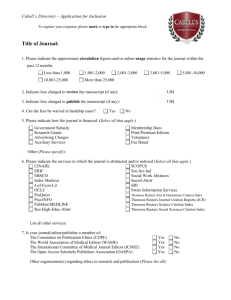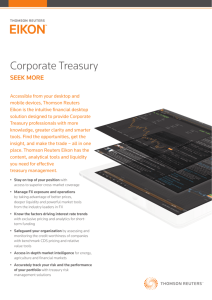
Essentials to Building a Winning
Business Case for Tax Technology
The complexity of the tax function continues to evolve
beyond manual and time-consuming processes. Technology
has been essential in managing the tax function with
the increased complexity of tax, escalating level of risk,
electronic audit trail requirements, the need for greater
transparency to ensure adequate review and control, and the
need for accurate tax results quickly.
The right technology for Tax has the ability to catapult an
organization to the next level of cost reduction, automation,
and overall operational efficiency. Conversely, the wrong
technology poses risks and can produce the opposite effect.
As tax departments continue to embrace this reality, there is
an uptick in the number of companies engaged in proactive
planning for their tax technology needs and new leading
practices are emerging.
The development of formal and informal business cases
to support tax technology investments is an area receiving
growing attention inside companies and throughout the
broader marketplace. Business cases have been in use for
a long time and serve as the basis to capture reasoning for
starting a project or initiative, including the purpose, scope,
estimated cost, and expected benefit.
Until recently, tax departments were not required to submit
business cases because either the bulk of their needs were
driven by regulatory requirements, or they self-funded
technology purchases through general budget dollars
approved for the tax department. This is quickly changing
as organizations require Tax to participate in centralized
technology management and compete with other areas of
the business for funding. Tax must make an organized and
compelling argument to obtain the necessary investment to
evolve and automate tax operations.
Tax professionals must be equipped with the knowledge
and skills to build and win their case for investments. This
practice aid outlines a handful of essential elements to get
you started on the path to success.
WHAT ARE THE REQUIREMENTS?
Let’s face it, everyone has plenty to do. You cannot afford
to waste time headed in the wrong direction. While every
investment in tax technology should have a defined purpose
and clear rationale, the format of your business case is driven
by your organization’s requirements. Ask yourself:
1
• Who (or what business unit) requires the case?
oTax Leadership, IT, Finance, Procurement?
• What is the format?
oWritten? Verbal? Is there a template? Is it formal?
• What elements must be included?
oScope of implementation? License fees?
• What is the need / problem being addressed?
oWhat is the scope of the project?
oWhat are the marketplace options?
• Who is the audience for the document?
oDoes it cross multiple business units and levels of
responsibility?
• What is the timing and frequency?
oDoes it align to annual budget cycles? How many
times per year are requests considered?
• How will changes in circumstances be evaluated?
A business case is written to persuade and is directed at a
main audience of key decision makers. Understanding what
they are looking for is a critical first step.
ALIGN TO YOUR TAX TECHNOLOGY STRATEGIC
PLAN AND ROADMAP
It would seem common sense to suggest that Tax must
ensure that all investment in technology has a purpose.
After all, why would we invest in technology that doesn’t
have a purpose? More precisely, Tax must ensure that the
investment in technology is planned in a comprehensive
fashion and aligned to Tax’s strategy. Your business case is
really just the culmination of an extensive effort to determine
the direction for tax technology.
Oftentimes, Tax identifies a gap in planning when they
prepare a business case and realize that an exercise to
document the strategic plan and approach for future tax
systems has not been performed. By taking steps “toward
a stronger and more comprehensive approach to planning
for future tax systems before decisions are made…your team
will be empowered to influence a more efficient operation
and align more effectively with the broader objectives of tax
operations as a whole.” 1
Tax cannot rely solely on tax acumen when organizing an
approach to persuade the organization to invest in tax
Thomson Reuters Tax & Accounting. Kovar, Lauren B. 4 Steps to Evaluating Tax Technology. 2014.
tax.thomsonreuters.com/taxologist/
1 — ESSENTIALS TO BUILDING A WINNING BUSINESS CASE FOR TAX TECHNOLOGY
technology. By aligning your business case to a holistic tax
technology strategy and objectives, decision makers will
join in your discussions toward a bigger picture result and
have better information when prioritizing funding for each
individual project request. Depending on the requirements,
consider writing your business case to cover multiple related
projects slotted in the tax roadmap.
UNDERSTAND ORGANIZATIONAL DRIVERS
AND CONSTRAINTS
Every area of your business has a different set of priorities,
and organizational drivers will play a large role in defining
which projects receive funding. Examples of these drivers
include:
• Short financial statement close windows
• Transformation initiatives
• Disparate Enterprise Resource Planning (ERP)
landscapes
• Shared service centers / centers of excellence
• Heavy acquisitions
• Overall risk adversity
These drivers are distinguishable from environmental
drivers, which may include economic factors, increased
regulatory scrutiny, or the impact of globalization.
Organizational drivers provide insight into the culture,
attitudes, and priorities of leadership. They often tell of
the current strategy and will ultimately influence where the
money goes.
Work to align Tax’s needs with those of the organization as
indicated by the drivers. Clearly illustrate those connections
in your business case and how the investment in Tax’s
initiative supports or leverages opportunity produced by
broader business goals.
THE 3 Ds – DUE DILIGENCE AND
DOCUMENTATION
and detailed aspects of the expected spend, as well as the
return on that investment, or ROI.
Quantitative data must be reliable and consistent to
the standards of the organization. For example, when
developing your metrics around employee time spent,
ensure you use the same values for “work hours per year”
and “average hourly rate” that are used in other reporting
and modeling. It is expected that estimates will be used –
especially when quantifying risk or efficiency. Methods used
and assumptions made in all estimates should be included
or available to support upon request.
Numbers without a story will not make the case. A wellarticulated discussion that builds from the beginning and
supports your technology preference is necessary to provide
context. If your technology request is associated with a
specific pain point in the tax department, document the
challenges in terms non-Tax readers can understand and
describe how your technology recommendation addresses
the issue. Layer quantitative statements in your narrative to
add validity.
A distinct business case for technology investment includes
the estimated cost (often as determined by effort) for
the full scope of the project—from planning and project
management through design, implementation, deployment,
and post-project phases. Technology license fees,
maintenance fees, and future phase costs should also be
incorporated.
In addition to the costs of the investment, metrics supporting
the business need and ROI are expected. To determine
these, ask yourself:
• What am I trying to measure?
• How do I measure it?
• How do I measure the cost associated with NOT making
the investment?
• What information do I need to compute the answer?
It is always easy to distinguish a business case that is thrown
together quickly and one that has followed a rigorous
process of due diligence. The strongest business cases win.
If you have done work to understand the requirements and
aligned to Tax’s strategy and organizational objectives, then
you can now turn your attention to the information you need
and how to present it.
Let’s say your organization is receiving information from
10 different sources and takes an average of 16 employee
hours to gather, compile, and analyze the data. This process
occurs 12 times per year for a total of 192 hours (16 x 12),
or nearly 10 percent of that employee’s time annually. By
automating this process, you can repurpose that time to
value-added activities and reduce the risk inherent in the
manual task of manipulating the data.
Your business case must include quantitative and qualitative
information and cover both the dollar value of the request
Consider incorporating the following sample metrics into
your business case:
2 — ESSENTIALS TO BUILDING A WINNING BUSINESS CASE FOR TAX TECHNOLOGY
• Employee hours to complete a specific task (e.g. tax
close)
• Number of system errors
• Number of IT support calls made
• Amount of time to train a new employee on the system
• Estimated fees and penalties
• Opportunity cost
• Spend on a la carte systems
• Expense on outside services
technology initiatives being proposed by business units
outside of Tax. These initiatives represent opportunities
for change that could “open the door for the tax function to
integrate itself better with the business and improve its data
management and collection processes — in turn enhancing
performance in areas such as global provision, compliance,
and tax planning.”3
Examples include:
• ERP implementations, consolidations, upgrades,
migrations
• Finance Transformation
A WORD ABOUT RISK
• Shared Services Centers and COEs
Finance has often built their business case around technology
and process improvement from the position of risk mitigation.
While risk will continue to remain a key driver for any tax
transformation, Tax has an opportunity to evaluate and
position themselves to provide value via improvement. There
are costs associated with being inefficient or using more than
one system to perform the same activity. In addition, many
companies have successfully identified direct tax savings
opportunities from their efforts to streamline and reform.
Incorporate quantifiable data using estimates where needed.2
• Supply-chain initiatives
Identifying risks comes naturally to tax professionals. Your
business case for technology must articulate the risks you
expect to mitigate with the solution. Risk can be measured
in different ways, from estimates of expected penalties
and fees to an increased potential for errors when moving
data between systems. If you are unsure how to quantify a
particular risk, seek input from your colleagues or trusted
advisor to suggest an approach.
Reduced risk is a component of ROI but will not likely have
a direct P&L impact unless there are costs being incurred
that are specifically related to that risk. The focus is avoiding
future costs associated with failing to mitigate risk.
LEVERAGE OPPORTUNITIES
Strategic and proactive planning for tax technology is about
opportunities, not just problem solving. Throughout your
strategic planning process, you will have identified multiple
• Capital expenditure planning
• Post-merger integration
Building a business case is necessary to receive an
allocation of the overall project funding toward Tax’s specific
requirements and resource needs on an enterprise initiative.
Assemble the key project stakeholders and owners of the
initiative to gather the inputs needed and begin the verbal
process of championing them to your cause. Learn more
about the effort and educate them on its importance to Tax.
Be prepared to show them why how your results impact
them.
BUILDING UPON SUCCESSES
Your request has been approved! But don’t stop there.
What about the next request? Start planning right away by
leveraging your successes.
By tracking and validating the success of your current
project and measuring against the metrics developed in
your business case, you add an additional dimension to
your story. Facts speak for themselves and testimonials are
powerful tools. Build credibility for your overall strategy and
planned approach to technology. When it is time to lobby
for Tax’s next purchase, you’ll be able to better support your
claims, persuade your stakeholders, and grab their attention
more quickly.
2
Thomson Reuters Tax & Accounting. Kovar, Lauren B. 4 Steps to Evaluating Tax Technology. 2014.
tax.thomsonreuters.com/taxologist/
3
Deloitte LLP. Tax and Business Transformation: Using Technology to Elevate the Tax Department’s Role. 2011.
deloitte.com/assets/Dcom-UnitedStates/Local%20Assets/Documents/us_tax_TaxBusTransformation_051011.pdf
3 — ESSENTIALS TO BUILDING A WINNING BUSINESS CASE FOR TAX TECHNOLOGY
Remember these tips:
• Everyone impacted by your current initiatives are potential advocates for your next project
• Seek new technology that is aligned to your strategy
• Develop sound bites to share your successes on a moment’s notice
• Define and measure incremental benefits throughout your projects
IN CONCLUSION
Tax professionals must be equipped with the knowledge and skills to build and win their case for
investment in technology. To move from the whiteboard to an actionable plan forward requires
a proactive and methodical approach to building a compelling business case. Using these
essentials, you give your project its best chance for success.
ABOUT THE EXPERT
Lauren B. Kovar
CPA/CITP, CGMA
Director – Client Advisory & Strategy
Thomson Reuters
Lauren is an expert in accounting transformation, tax technology strategy and finance improvement. Lauren advises Fortune
500 companies on leading practices for tax operations and technology. Her expertise covers the broad landscape of tax and
beyond to areas of general process automation and data management.
Prior to joining Thomson Reuters, Lauren developed and led the Global Tax Technology function for General Motors where she
designed and implemented the long-term strategic technology and process improvement vision for the global tax function. In
the past she has managed M&A work, Finance and ERP systems, general ledger accounting and reporting. She started her
career at KPMG, where she led audit engagements.
In 2012, Lauren received the AICPA’s Women to Watch – Emerging Leader Award. She is currently the Chair of the AICPA’s Tax
Information and Operations Task Force, and a member of the AICPA’s Information Management and Technology Assurance
(IMTA) Task Force and the CITP Credential Committee. Lauren was recently profiled for her work as a Chartered Global
Management Accountant.
4 — ESSENTIALS TO BUILDING A WINNING BUSINESS CASE FOR TAX TECHNOLOGY
800.259.6398 | tax.thomsonreuters.com
© 2014 Thomson Reuters/ONESOURCE. All Rights Reserved.
Form_1095-B_WP_05-2014









